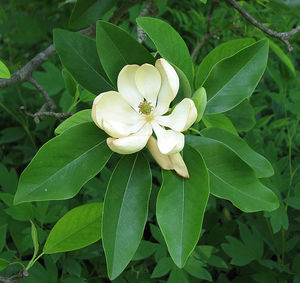Magnolia trees are easy to propagate and there are many varieties to choose among. Depending on the variety chosen, the U.S. Department of Agriculture zones varies from 4 through 10. Magnolia can grow to heights of 90 feet, or it can be grown as a bonsai. For people living in a colder climate, magnolia can grow as a houseplant. Magnolias have been a part of the Southern plantation picture for centuries.
Prepare the Pots
Place a coffee filter at the bottom of a 4-inch pot. The coffee filter keeps the soil from washing out of the pot every time you water. Fill the pots with well-drained potting soil. You will need to prepare one 4-inch pot for each magnolia that you wish to propagate.
Fill a tub or container with water, and place the pots inside. The water should not be above the top rim of the pots. Allow the pots to soak until the top is visibly wet. Remove the pots from the water and allow the excess water to drain.
While the pots are draining, it’s a good time to gather your cuttings. If the magnolia tree is on some one else’s’ property, ask permission before taking your cuttings. Before you go out to gather your cuttings, take along a wet paper towel and a plastic bag.
Gather the Cuttings
Examine the magnolia tree and find the stems with new growth. These will be green in color and pliable. If you bend them, they will not break. New growth is what you need for propagation.
Cut the stems, 4- to 6 inches in length, using a sharp knife or pruning shears. Cut or pinch off the leaves, but leave two to three at the tip. Wrap the cut end of the stems in the wet paper towel and place it in the plastic bag to contain the moisture in one place.
Prepare and Plant the Cuttings
When you get home, dip the cut end of the magnolia stem in water. Shake the cutting to remove the excess water and then dip the wet end into rooting hormone. Tap the cutting to remove the excess rooting hormone. You don’t need to use the rooting hormone, but many gardeners believe that it helps the cutting to root faster.
Form a hole in the damp potting soil with the blunt end of a pencil. Insert the end with the rooting hormone into the hole. Firm the soil in place around the cutting with you fingers to hold it upright.
Place a clear plastic bag over the pot. The bag helps retain moisture and humidity. Find a warm bright location for your cutting, but keep it out of direct sunlight.
Every other day, feel the soil for moisture. Add water to keep the soil moist. Do not let the soil remain soggy or the cutting will rot.
Check the cutting for roots. It can take sox weeks to two months for the roots to form. An indication to watch for is the emergence of new leaves. You can remove the cutting from the pot to check for roots, but this may set the cutting back by damaging any roots that may have formed.
Remove the clear plastic bag. This process can take six weeks to two months for the roots to form.
Sources:
Durio Nursery: Magnolias
Yardener: Magnolia
“American Horticultural Society A to Z Encyclopedia of Garden Plants”; Christopher Brickell; 2004
“National Garden Book”; Sunset Books; 1997


